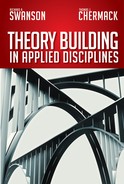PART THREE
Successful Theory Building
9 Case Example: Marsick and Watkins’s Learning Organization Theory
10 Case Example: Chermack’s Scenario-Planning Theory
11 Figuring Out the Present Status of a Theory
12 Whatcha Gonna Do?
THEORY BUILDING IS important work. Many scholars and scholarly practitioners avoid theory building because it can span over long periods of time. Concurrently, many expert practitioners avoid the detail and precision required to document what they know. Either way, knowledge is lost, and applied disciplines do not advance as much as they could.
Available examples of applied discipline theories rarely are complete—that is, displaying efforts through all five phases of the method. Unfortunately, people have all too often used the term theory building to refer to only the Conceptualize phase. For sure, the two general components of theory building—the theorizing itself, and the assessment of the adequacy of the theorizing—require different skill sets. It seems reasonable that divergent thinkers may be inherently well equipped to generate the ideas and concepts that form the basis of a theory, and convergent thinkers prefer to investigate particular aspects of theories that have already been postulated. Maybe some scholars are trained to begin their research by scouring the literature for relevant problems in journal articles on general topics of interest? They then pick up where others have left off. Another possible explanation is that some researchers begin by asking practitioners about their most pressing and difficult challenges. This inquiry leads to uncovering a variety of related practical problems but does not cover a sustained theory-building effort in the same realm over time in different contexts.
The reasons for small numbers of modern examples of theory building, from concept to assessment, are mostly left to speculation. What is of great importance is that established experts in applied disciplines consider the benefits of engaging in the full theory-building process—from concept to refinement. This approach can provide emerging experts with a research agenda to span a career and stands a much better chance at replicating solutions to practical problems. For a seasoned expert, there is the long-term satisfaction of deeply understanding a theoretical realm, developing robust explanations, and applying them in practice.
Part Three gives two comprehensive examples of theory building that have followed the five-phase theory-building method for applied disciplines. In addition, the phases and steps presented in this book are translated into a practical assessment tool for immediate use to figure out the present status of any theory. Finally, we conclude with a set of clear strategies to get started in theory-building work.
Chapter 9, “Case Example: Marsick and Watkins’s Learning Organization Culture Theory,” illustrates a specific theory of learning organization culture and how it demonstrates activity in all five phases. Each phase is described with regard to how the authors approached it, completed it, and may be revisiting it.
Chapter 10, “Case Example: Chermack’s Scenario-Planning Theory,” functions in the same illustrative way as Chapter 9. However, because coauthor Chermack’s theory is the focus of the content, we describe our recent firsthand experience with theory building, explaining our choices in detail.
Chapter 11, “Figuring Out the Present Status of a Theory,” is a translation of the five phases of this book into a usable assessment tool for determining the maturation and completeness of existing theories. The Theory in Applied Disciplines Status Assessment Tool is described and its use illustrated by applying it directly to the theories discussed in the previous two chapters.
Finally, Chapter 12, “Whatcha Gonna Do?” is a next-steps enticement into theory-building work. We hope to whet your theory-building appetite by providing three ways you can immediately engage in theory building: (1) auditing an existing theory, (2) testing an existing theory, and (3) building a new theory.
